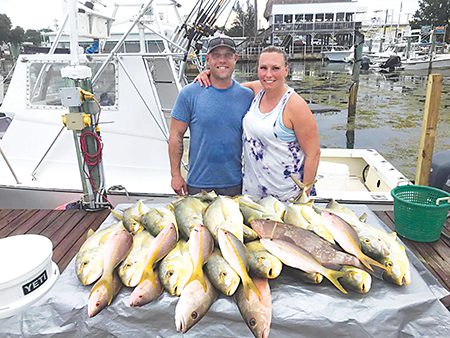
The SeaSquared crews tend to fish for yellowtails in the shallower reef areas in 30 to 50 feet of water. Standard size blocks of chum are all you need, as a smaller amount of food is required to hold their attention during the winter. These areas also contain plenty of king and cero mackerel, so prepare to fire up your smoker. Live ballyhoo or live pilchards will draw their interest.
As a reminder, grouper season closed on January 1. So, ALL grouper must be released unharmed. You’ll find more consistent snapper action around the humps in Hawk Channel. Fresh shrimp and live pilchards are your baits of choice. Fish them on a jighead on the bottom for the best results.
There’s no telling what you may catch when that shrimp hits the bottom. Snappers, groupers, cobias, porgies, hogfish (which also must be released as that season is closed as well) plus Spanish, cero and king mackerel.
We anticipate the sailfish action to be quite good on the reef, especially with the bumper crop of ballyhoo available for them to feed on. Up and down the reef, chasing sailfish that are spraying ballyhoo is common practice during January for guys in the know.
As saifishing is sight-fishing at its finest, a boat with a tower of some sort offers the best vantage for spotting fish. No tower? Try heading off the reef edge to the 100- to 150-foot depths and putting out a spread of four to six live ballyhoo while drifting a color change, current break or weed line. The live ballyhoo should attract the sailfish and lure them to your boat. No sailfish has ever passed up a live ballyhoo in the danger zone.
Among the sails, you may also encounter large blackfin tuna in the 15- to 20-pound class. On occasion, dolphin, wahoo and king mackerel are roaming the same areas. In the bayside waters, mangrove snappers and Spanish mackerel hang on the inshore wrecks and banks. Further out, you’ll find cobias, Goliath groupers, blacktip sharks and more, all responding to your efforts.
— Capt. Chris Johnson and his fleet of six boats specialize in offshore,
gulf/bay, reef/wreck, sailfish, shark, tarpon and lobster fishing with SeaSquared Charters in Marathon. You can reach them at 305-743-5305,
http://SeaSquaredCharters.com and http://Facebook.com/MarathonFishing.
